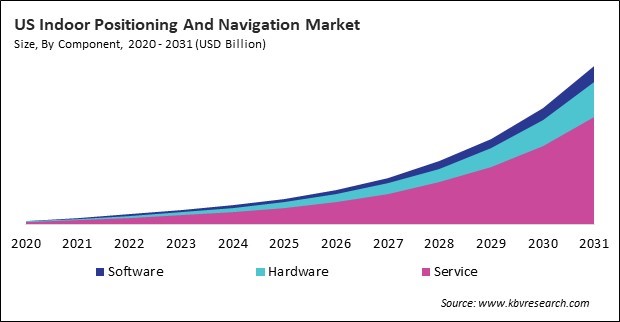The North America Indoor Positioning And Navigation Market would witness market growth of 36.5% CAGR during the forecast period (2024-2031).
The US market dominated the North America Indoor Positioning And Navigation Market by Country in 2023, and would continue to be a dominant market till 2031; thereby, achieving a market value of $53,233.9 million by 2031. The Canada market is experiencing a CAGR of 39.1% during (2024 - 2031). Additionally, The Mexico market would exhibit a CAGR of 38.3% during (2024 - 2031).

The market is an evolving segment of the broader location-based services (LBS) industry, poised to significantly impact various sectors by enhancing operational efficiencies, improving user experiences, and providing innovative solutions to complex challenges within indoor environments. Unlike outdoor positioning systems that rely on navigation satellite systems (GNSS) such as GPS, indoor positioning systems (IPS) leverage various technologies to determine the precise location of objects and individuals within buildings. The demand for such systems is growing rapidly, driven by the increasing need for real-time location information in diverse applications, from retail and healthcare to transportation and smart buildings.
The proliferation of smartphones and mobile applications is one of the primary factors driving the market. This has facilitated the access and utilization of indoor navigation services for businesses and consumers. Various sensors, such as accelerometers, gyroscopes, and magnetometers, are incorporated into contemporary smartphones. When combined with technologies such as Bluetooth Low Energy (BLE), Wi-Fi, and Ultra-Wideband (UWB), these sensors can deliver precise and real-time data regarding the device's location inside the building.
The rising demand for these technologies in Mexico is driven by rapid urbanization and government initiatives to enhance digital connectivity. According to the National Institute of Statistics and Geography (INEGI), about 78% of the population had internet access in 2022, with a significant push towards improving digital infrastructure. The Mexican government’s National Digital Strategy aims to enhance connectivity and digital services across the country, supporting the deployment of indoor navigation technologies. In the retail sector, major shopping centers and stores are adopting indoor positioning to offer better customer service and personalized experiences. Moreover, the healthcare sector is increasingly utilizing these technologies for patient tracking and efficient management of medical facilities. Hence, these factors will aid in the growth of the market.
Free Valuable Insights: The Indoor Positioning And Navigation Market is Predict to reach USD 208.6 Billion by 2031, at a CAGR of 37.2%
Based on Component, the market is segmented into Software, Hardware, and Service. Based on Technology, the market is segmented into Bluetooth Low Energy, Ultra-Wideband Technology, Wi-Fi, and Others. Based on Application, the market is segmented into Asset & Personnel Tracking, Location-Based Analytics, Navigation & Maps, and Others. Based on End Use, the market is segmented into Retail, Manufacturing, Healthcare, Travel & Hospitality, Public Spaces, Office Spaces, Logistics & Warehouses, and Others. Based on countries, the market is segmented into U.S., Mexico, Canada, and Rest of North America.
By Component
By Technology
By Application
By End Use
By Country
Our team of dedicated experts can provide you with attractive expansion opportunities for your business.

